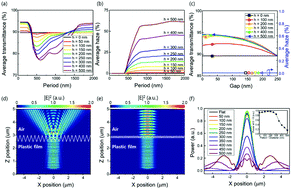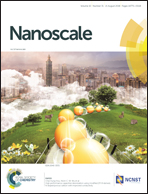A strain induced subwavelength-structure for a haze-free and highly transparent flexible plastic substrate†
Abstract
This paper presents a method to produce subwavelength-scale (<250 nm) AgCl nanostructures on a flexible plastic film, which is indispensable for highly efficient flexible displays. Using Cl2 plasma treatment on an Ag-coated plastic film, AgCl nanostructures were produced through the reaction of Ag atoms with Cl radicals. During the reaction, the volume of AgCl expands, leading to drastically changed surface morphology from a two-dimensional (2D) flat Ag surface to a 3D subwavelength-scale AgCl nanostructure. The optical properties of AgCl on the plastic film were remarkably enhanced from 89.6% to 93.4% and the average transmittance ranged between 400 and 800 nm, while the average haze was retained below 0.3%. Consequently, OLEDs based on the subwavelength-scale AgCl nanostructure had an enhanced luminance efficiency (88.6 cd A−1 at 1000 cd m−2) of up to 10.7% without modifying the angular emission pattern, superior to that of the as-received PI film (efficiency of 80.0 cd A−1). The nanostructure enhances the transmission of electromagnetic (EM) waves as well as prohibits the scattering of EM waves, which was confirmed by finite-difference time-domain simulation and rigorous coupled wave analysis.



 Please wait while we load your content...
Please wait while we load your content...